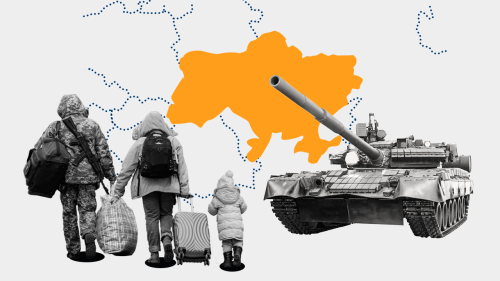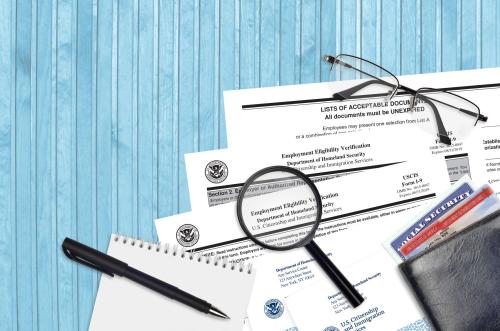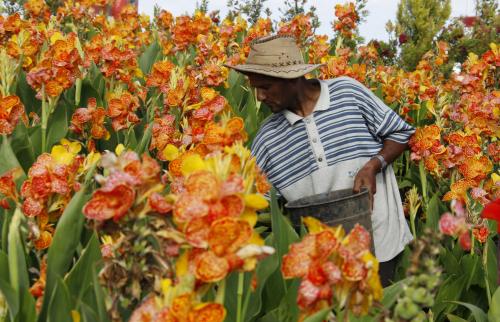One of the main objectives of the Great Lakes Process is to create lasting conditions for security, stability, sustainable development and reconstruction in the region as a whole (Article 2, c Pact on Security, Stability and Development in the Great Lakes Region). What can international law pertaining to internally displaced persons in general and the Great Lakes Protocol on IDPs in particular contribute to achieve this goal? What are, in this context, the most pressing challenges that should be addressed?
The magnitude of the problem
Let me start with recalling the magnitude of the problem. According to IDMC, about half of the IDPs of the world today live on the African continent and about half of these internally displaced persons are in the Great Lakes region.[1] Sudan alone counts for more than 5 million IDPs, followed by Northern Uganda with until recently 1.7 million and the DRC with 1.1 million.
Armed conflicts are the primary cause of displacement in the region. Such displacement continues in many countries such as the Democratic Republic of Congo (DRC), Sudan (Darfur), the Central African Republic (CAR) or Kenya. Natural disasters and urbanization projects also continue to cause significant displacement. The recent floods affecting Africa have also hit countries of the sub-region, including Uganda and Sudan causing large scale displacement.
At the same time, some initiatives towards peace and development in the region are successful or at least promising. The conflict between states in the region is over and the ratification of the Pact on Security, Stability and Development in the Great Lakes Region will seal this peace. Regarding internal armed conflicts, peace agreements have been concluded in Burundi, southern Sudan and DRC. Serious negotiations to end the war in northern Uganda are now underway and it remains to be hoped that negotiations with rebel groups in Darfur and CAR will be successful. Large numbers of displaced persons have been able to return to their homes across the region in Angola, Burundi, southern Sudan, and, to a certain extent northern and eastern Uganda.
However, sustainable solutions to the plight of the IDPs in the region have not in most of the cases accompanied these evolutions. Even when IDPs return home they encounter considerable obstacles to reintegration and other durable solutions, i.e. local integration where they have been displaced to or resettlement to another part of the country. As regards return, experience shows that the successful return of IDPs and refugees to their homes and former places of habitual residence is based on three elements: ensuring the safety of returnees; returning property to the displaced and reconstruction of their houses; and creating an economic, social and political environment that sustains return.
Durable solutions for IDPs in the Great Lakes region and the challenges of peace-building
Many elements of these basic conditions are important components of peace-building efforts, and the extent to which durable solutions for displaced persons can be found may hinge on whether or not such efforts are successful in a particular situation. Like in other parts of the world, finding durable solutions for IDPs and effective peace-building, thus, are intrinsically linked in the Great Lakes region, too.[2]
On the one hand, failure to consider IDP concerns may jeopardize the sustainability of peace in the country. For example, when displaced people must return to areas where armed groups that have displaced them are still present or where access to their land is dangerous because of landmines return might not take place. If IDPs are not able to recover their land or property or otherwise find solutions allowing them to live decent lives and when they feel that they have suffered injustice, reconciliation becomes more difficult. If durable solutions are not found for IDPs, their potential for contributing to economic reconstruction and rehabilitation is limited and poverty reduction becomes more difficult. Similarly, the exclusion of IDPs from political participation can reinforce feelings of marginalization and make it more difficult for a new government to claim legitimacy. In contrast, resolution of such issues can be a positive force for social rehabilitation and thus lasting peace. Experience has shown that IDPs who return can play an important role in re-building their homes and communities and thus in contributing to the economic development of the country. Ensuring that IDPs are able to participate in the political process can be a tangible expression of a commitment to adopt policies of inclusiveness that strive to be responsive to the needs of marginalized and victimized parts of the population.
At the same time, neglecting peace-building measures may seriously undermine efforts to find durable solutions for the displaced. For example, if the situation in communities of origin is not perceived as safe by displaced persons, they will not return. Or, if they do return, they may move again if security is inadequate. Similarly, if property related disputes are not solved and property not restituted to returnees and if reconstruction and economic rehabilitation remain insufficient to enable the displaced to resume economic livelihoods, return will not be sustainable. Political transitions need to take into account the particular needs of IDPs, for example to enable them to vote on interim political arrangements and to participate in the political life of the country – even before they return to their communities of origin. Finally, issues of reconciliation are closely related to issues of justice and accountability for past crimes and to demands for restitution or compensation for losses which have been experienced. The way in which these issues are resolved will have a major impact on the security and stability in the country.
My mission reports, including those to member states of the Great Lakes Conference show that in post-conflict situations, peace-building activities in the following areas are particularly relevant for displaced persons and returnees:
- Providing security through demobilization, de-mining, reestablishing the rule of law, combating impunity, etc.;
- Solving property-related problems (reconstruction and restitution of property; resolution of property related disputes);
- Furthering reconciliation between local communities and returnees;
- Undertaking post-conflict reconstruction i.e. re-establishing basic infrastructure and services as well as ensuring access to services, resources and livelihoods; and
- Ensuring the political transition to and the establishment of an effective and legitimate government in which the various sectors of society, including IDPs and returnees, can become stakeholders.
The Great Lakes Pact and its Protocols
The Great Lakes Pact with its ten Protocols and four Programmes of Action is one of the few international agreements that address internal displacement in a comprehensive and holistic manner. It covers not only conflict induced displacement but also displacement caused by natural disasters and induced by development projects. Thus, it is forward-looking and goes beyond the current peace-building challenges in the Great Lakes region. The Protocol is also innovative insofar as it puts a particular emphasis on implementation by providing model legislation on the implementation of the Protocol as well as a regional action programme for the protection, assistance and search for durable solutions for displaced populations and communities that host them.
The Protocol on the Protection and Assistance to Internally Displaced Persons establishes a legal framework for the protection of IDPs through incorporation of the Guiding Principles into domestic law, providing measures aimed at protecting the physical safety and material needs of the displaced, and creating obligations to prevent and address the root causes of displacement. From a legal perspective, Article 6 of the Protocol on IDPs is of particular interest. It obliges states parties “to adopt and implement the Guiding Principles as a regional framework for providing protection and assistance to internally displaced persons in the Great Lakes Region”, to “use the ‘Annotations of the Guiding Principles on Internal Displacement’” as an authoritative source for interpreting the application of the Guiding Principles” and to “enact national legislation to domesticate the Guiding Principles fully and to provide a legal framework for their implementation within national legal systems”. Article 6 further addresses the content of such legislation by providing, inter alia, that it shall prescribe the procedures for relocation in the context of development projects and, more generally, “specify the organs of government responsible for providing protection and assistance to internally displaced persons, disaster preparedness and the implementation of the legislation incorporating the Guiding Principles”. Finally, states have to “ensure the effective participation of internally displaced persons in the preparation and design” of such legislation.
This is a very innovative approach to how states should deal with soft law in their attempts to strengthen the protection of the rights of IDPs. The 1998 Guiding Principles on Internal Displacement which, as requested by the then UN Human Rights Commission, were prepared by Dr. Francis Deng in his capacity as Representative of the Secretary General on Internal Displacement, set out in detail the rights of IDPs in 30 principles covering the predisplacement phase, protecting during displacement as well as the rights of IDPs at a time when durable solutions can be found. While the Guiding Principles are based upon and consistent with relevant guarantees of human rights and international humanitarian law, often just making explicit what is implicit in the rather abstract guarantees of relevant conventions, they are, as such, non-binding. While, in 2005, Secretary General Kofi Annan called on States States to “promote the adoption of [the Guiding Principles on Internal Displacement] through national legislation” (A/59/2005, para. 210), the drafters of the Pact and the Protocol went one step further. Here it is international agreement adopted at a sub-regional level that makes incorporation of the Guiding Principles into domestic law an obligation. This is a very promising way to build consensus on the need to legally protect IDPs and on the content of such protection bottom-up; it could serve as an example for other regions.
However, the provisions of the Protocol on IDPs alone would no be sufficient to find durable solutions for IDPs in the region. What is really innovative is the fact that the Pact provides a legal foundation to link the IDP Protocol with other relevant protocols addressing issues outlined above as being particularly important from a peacebuilding perspective. In this regard, the Protocol on Property Rights of Returning Persons and the Protocol for the Prevention and the Punishment of the Crime of Genocide, War Crimes and Crimes against Humanity and all forms of Discrimination, as well as the Regional Programme of Action for Humanitarian and Social Issues are particularly important.
Challenges
What are the main challenges in front of us? Besides the many political obstacles to finding durable peace, security and development in the Great Lakes region, the number one challenge is implementation. Beyond the immediate requirement for the member states of the Great Lakes Conference to ratify the Pact and its Protocols, adopt the necessary legislation and allocate the necessary resources, the processes leading to effective and sustainable security, stability and development in the Great Lakes Region, including durable solutions for IDPs, require to deal with a number of complex challenges that might become obstacles if not properly addressed. They include:
- The tension between accountability and reconciliation: International law rightly insists on the duty of states to hold those responsible for war crimes and crimes against humanity and peace without justice is most often not sustainable. Therefore, accountability and reconciliations are not mutually exclusive. Nevertheless, more thought is needed how to bring the two principles together where the issue of criminal proceedings makes it more difficult to conclude and implement peace agreements.
- The solution of conflicts between competing property claims: While resolving property issues through restitution or is of paramount importance for finding durable solutions for IDPs, there are situations where claims by persons displaced at different times may legitimately compete with each other.
- The inclusion of sub–national authorities and traditional communities and the IDPs themselves into efforts to find durable solutions: Often, implementation efforts could be much more efficient and sustainable of national governments would include local authorities, traditional communities and IDPs themselves into such endeavors. However, this would require more clarity about the respective roles and relationships between the different actors.
- The gap between humanitarian assistance and development: At the level of the international community, there is still a gap in terms of funding mechanisms between humanitarian assistance (with often a short term perspective) and development aid (with its long-term approach), making it often extremely difficult to fund early recovery activities when humanitarian assistance and development activities addressing immediate needs for basic infrastructure and services must go hand in hand in order to find durable solutions for internally displaced persons.
*Dr. iur (Bern), LL.M (Harvard), Professor of constitutional and international law at the Faculty of Law of the University of Bern/Switzerland; Representative of the UN Secretary-General on the Human Rights of Internally Displaced Persons. Part of this paper draws on: Internal Displacement and Peacebuilding: A Contribution to the Discussion, submitted to the Peacebuilding Commission by the Representative of the Secretary-General on the Human Rights of Internally Displaced Persons, available at: https://www.brookings.edu/idp.
[1] Enhancing Protection of Displaced Populations: Translating the Great Lakes Peace Pact into Action, IDMC, April 2007, available at http://www.internal-displacement.org.
[2] See, e.g. the reports by the Representative of the Secretary-General on the Human Rights of IDPs to the Human Rights Council and the General Assembly on his missions and visits as to Southern Sudan (E/CN.4/2006/71/Add.6, in particularly paras. 39-58), Uganda (A/61/276, paras. 33-34) and the Central African Republic (forthcoming).



Commentary
The Great Lakes Protocol on Internally Displaced Persons: Responses and Challenges
September 27, 2007